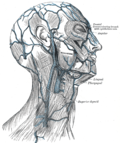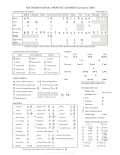[w] refers to a labial–velar approximant. In phonology, labialization may also refer to a type of assimilation process. Labialization is the most widespread...
23 KB (1,067 words) - 20:38, 30 October 2024
Look up labial in Wiktionary, the free dictionary. The term labial originates from Labium (Latin for "lip"), and is the adjective that describes anything...
504 bytes (105 words) - 20:01, 25 March 2019
not have any actual labialization. All of these languages have seen labials introduced under the influence of English. Labialization Index of phonetics...
4 KB (451 words) - 01:44, 6 December 2023
Labio-palatalization (redirect from Labial–palatal consonant)
palatalized consonants plus labialization, ⟨ʷ⟩, as with the [sʲʷ] = [sᶣ] of Abkhaz or the [nʲʷ] = [nᶣ] of Akan. A voiced labialized palatal approximant [ɥ]...
3 KB (284 words) - 00:45, 15 July 2024
labialized voiceless velar plosive [kʷ] and labialized voiced velar plosive [ɡʷ], obstruents being common among the sounds that undergo labialization...
4 KB (402 words) - 23:13, 12 July 2024
The voiced labial–velar approximant is a type of consonantal sound, used in certain spoken languages, including English. It is the sound denoted by the...
20 KB (1,009 words) - 07:03, 22 November 2024
The labial glands are minor salivary glands situated between the mucous membrane and the orbicularis oris around the orifice of the mouth. They are circular...
1 KB (146 words) - 16:04, 8 May 2024
Labial fusion is a medical condition of the vulva where the labia minora become fused together. It is generally a pediatric condition. Labial fusion is...
7 KB (658 words) - 17:11, 12 July 2024
The superior labial branches (labial branches), the largest and most numerous, descend behind the quadratus labii superioris, and are distributed to the...
946 bytes (82 words) - 02:21, 21 April 2022
Labial nerves can refer: Posterior labial nerves, branches of the pudendal nerve Anterior labial nerves, branches of the ilioinguinal nerve Superior labial...
239 bytes (61 words) - 04:39, 29 December 2019
distinguish protruded and compressed rounding, an old diacritic for labialization, ⟨ ̫⟩, will be used here as an ad hoc symbol for the protruded palatal...
15 KB (1,237 words) - 15:29, 21 November 2024
The inferior labial vein is the vein receiving blood from the lower lip. Lateral head anatomy detail Head anatomy anterior view...
804 bytes (21 words) - 16:04, 8 May 2024
Labial vein may refer to: Inferior labial vein Posterior labial veins Superior labial vein This disambiguation page lists articles associated with the...
129 bytes (46 words) - 12:51, 29 December 2019
The extinct language Volow had a prenasalised labial-velar stop with labialization [ᵑ͡ᵐɡ͡bʷ]. Bilabial clicks are stops that involve closure at both the...
10 KB (848 words) - 16:44, 25 September 2024
Pronunciation of English /r/ (redirect from R-labialization)
as is its overlap with rhotacism; see § R-labialization below) In most British dialects /r/ is labialized [ɹ̠ʷ] in many positions, as in reed [ɹʷiːd]...
10 KB (1,156 words) - 15:59, 16 July 2024
The labial scales are the scales of snakes and other scaled reptiles that border the mouth opening. These do not include the median scales on the upper...
1 KB (187 words) - 22:33, 5 November 2022
Roundedness (category Labial consonants)
consonantal labialization. Thus, rounded vowels and labialized consonants affect one another by phonetic assimilation: Rounded vowels labialize consonants...
24 KB (2,486 words) - 02:09, 3 November 2024
Bilabial stop (redirect from Labial stop)
Nasal n͡m Labial–alveolar ɳ͡m Labial–retroflex ŋ͡m Labial–velar Plosive t͡p d͡b Labial–alveolar ʈ͡p ɖ͡b Labial–retroflex k͡p ɡ͡b Labial–velar q͡ʡ Uvular–epiglottal...
1 KB (159 words) - 14:46, 18 September 2022
Labial artery may refer to Inferior labial artery Posterior labial arteries Prominent inferior labial artery Superior labial artery This disambiguation...
176 bytes (50 words) - 04:39, 29 December 2019
Labial–retroflex consonants are doubly articulated consonants that are co-articulated at the lips and with the front part or underside of the tongue against...
2 KB (180 words) - 20:52, 22 August 2024
A labial fricative is a fricative consonant, whose articulation involves the lips. Several kinds can be distinguished based on whether the articulation...
895 bytes (94 words) - 13:39, 16 January 2024
Labial–uvular consonants (also labio-uvular consonants) are doubly articulated consonants that occur at two places of articulation, the lips and the uvula...
2 KB (194 words) - 15:36, 11 July 2024
The voiceless labial–velar fricative is a type of consonantal sound, used in spoken languages. The symbol in the International Phonetic Alphabet that represents...
10 KB (855 words) - 09:53, 25 September 2024
Bilabial click (redirect from Labial click)
from labialization of other places of articulation. Starostin (2003) notes that the ǂ’Amkoe words for 'one' and 'two', /ʘ̃ũ/ and /ʘoa/, have labial clicks...
12 KB (1,091 words) - 07:18, 20 August 2024
posterior labial nerves are superficial branches of the perineal nerve, which in itself is a branch of the pudendal nerve. The posterior labial nerves provide...
2 KB (149 words) - 00:44, 18 October 2024
W indicates either simultaneous velarization and labialization, as in ⟨sʷ⟩ or ⟨pʷ⟩, or labialization of a velar consonant, as in ⟨kʷ⟩. Although electropalatographic...
8 KB (821 words) - 09:37, 28 July 2024
the 'less rounded' diacritic under the labialization diacritic, ⟨xʷ̜⟩, makes it clear that it is the labialization that is 'less rounded' than its cardinal...
166 KB (16,108 words) - 05:49, 22 November 2024
distinction disappears with the approximant consonant [w] since labialization involves adding of a labial approximant articulation to a sound, and this ambiguous...
14 KB (1,112 words) - 04:31, 22 November 2024
Labial commissures may refer to: Anterior commissure of labia majora (commissura labiorum anterior) Posterior commissure of labia majora (commissura labiorum...
518 bytes (60 words) - 01:17, 29 March 2024
Labia majora (redirect from Anterior labial commissure)
variable degree. The labia majora are thicker in front, and form the anterior labial commissure where they meet below the mons pubis. Posteriorly, they are not...
9 KB (979 words) - 02:33, 30 September 2024









